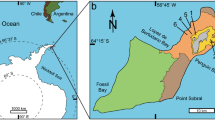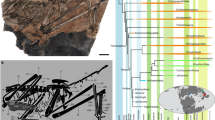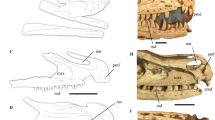Abstract
The lacustrine deposits of the Yixian and Jiufotang Formations in the Early Cretaceous Jehol Group in the western Liaoning area of northeast China are well known for preserving feathered dinosaurs, primitive birds and mammals1,2,3. Here we report a large basal bird, Jeholornis prima gen. et sp. nov., from the Jiufotang Formation. This bird is distinctively different from other known birds of the Early Cretaceous period in retaining a long skeletal tail with unexpected elongated prezygopophyses and chevrons, resembling that of dromaeosaurids4,5,6, providing a further link between birds and non-avian theropods7,8. Despite its basal position in early avian evolution, the advanced features of the pectoral girdle and the carpal trochlea of the carpometacarpus of Jeholornis indicate the capability of powerful flight. The dozens of beautifully preserved ovules of unknown plant taxa in the stomach represents direct evidence for seed-eating adaptation in birds of the Mesozoic era.
This is a preview of subscription content, access via your institution
Access options
Subscribe to this journal
Receive 51 print issues and online access
$199.00 per year
only $3.90 per issue
Buy this article
- Purchase on Springer Link
- Instant access to full article PDF
Prices may be subject to local taxes which are calculated during checkout




Similar content being viewed by others
References
Ji, Q., Currie, P. J., Norell, M. A. & Ji, S.-A. Two feathered dinosaurs from northeastern China. Nature 393, 753–761 (1998)
Hou, L.-H., Zhou, Z.-H., Martin, L. D. & Feduccia, A. A beaked bird from the Jurassic of China. Nature 377, 616–618 (1995)
Wang, Y., Hu, Y., Meng, J. & Li, C. An ossified Meckel's cartilage in two Cretaceous mammals and origin of the mammalian middle ear. Science 294, 257–361 (2001)
Ostrom, J. H. Osteology of Deinonychus antirrhopus, an unusual theropod from the Lower Cretaceous of Montana. Peabody Mus. Nat. Hist. Yale Univ. Bull. 30, 1–165 (1969)
Xu, X., Wang, X.-L. & Wu, X.-C. A dromaeosaurid dinosaur with a filamentous integument from the Yixian Formation of China. Nature 401, 262–266 (1999)
Xu, X., Zhou, Z.-H. & Wang, X.-L. The smallest known non-avian theropod dinosaur. Nature 408, 705–708 (2000)
Padian, K. & Chiappe, L. M. The origin and early evolution of birds. Biol. Rev. 73, 1–42 (1998)
Sereno, P. C. The evolution of dinosaurs. Science 284, 2137–2147 (1999)
Norell, M. et al. ‘Modern’ feathers on a non-avian dinosaur. Nature 416, 36–37 (2002)
Zhou, Z.-H. & Zhang, F.-C. Two new ornithurine birds from the Early Cretaceous of western Liaoning, China. Chinese Sci. Bull. 46, 1258–1264 (2001)
Zhou, Z.-H. & Zhang, F.-C. Largest bird from the Early Cretaceous and its implications for the earliest avian ecological diversification. Naturwissenschaften 89, 34–38 (2002)
Zhang, F.-C., Zhou, Z.-H., Hou, L.-H. & Gu, G. Early diversification of birds: evidence from a new opposite bird. Chinese Sci. Bull. 46, 945–950 (2001)
Xu, X. & Wu, X.-C. Cranial morphology of Sinornithosaurus millenii (Dinosauria: Theropoda: Dromaeosauridae) from the Yixian Formation of Liaoning, China. Can. J. Earth Sci. 38, 1–14 (2001)
Wellnhofer, P. A. A new specimen of Archaeopteryx from the Solnhofen Limestone. Nat. Hist. Mus. Los Angeles County Sci. Ser. 36, 3–23 (1992)
Wellnhofer, P. A. Das siebte Exemplar von Archaeopteryx aus den Solnhofener Schichten. Archaeopteryx 11, 1–48 (1993)
Sanz, J. L., Chiappe, L. M. & Buscalioni, A. D. The osteology of Concornis lacustris (Aves: Enantiornithes) from the lower Cretaceous of Spain and a re-examination of its phylogenetic relationships. Am. Mus. Novit. 3133, 1–23 (1995)
Martin, L. D., Zhou, Z.-H., Hou, L. & Feduccia, A. Confuciusornis sanctus compared to Archaeopteryx lithographica. Naturwissenschaften 85, 286–289 (1998)
Chiappe, L. M., Ji, S.-A., Ji, Q. & Norell, M. A. Anatomy and systematics of the Confuciusornisthidae (Theropoda: Aves) from the Late Mesozoic of Northeastern China. Bull. Am. Mus. Nat. Hist. 242, 1–89 (1999)
Zhang, F.-C. & Zhou, Z.-H. A primitive enantiornithine bird and the origin of feathers. Science 290, 1955–1959 (2000)
Norell, M. A. & Makovicky, P. Important features of the Dromaeosaur skeleton: information from a new specimen. Am. Mus. Novit. 3215, 1–28 (1997)
Novas, F. E. & Puerta, P. F. New evidence concerning avian origin from the Late Cretaceous of Patagonia. Nature 387, 390–392 (1997)
Forster, C. A., Sampson, S. D., Chiappe, L. M. & Krause, D. W. The theropod ancestry of birds: new evidence from the Late Cretaceous of Madagascar. Science 279, 1915–1919 (1998)
McGowan, C. Evolutionary relationships of ratites and carinate: evidence from ontogeny of the tarsus. Nature 315, 159–160 (1984)
Sun, G., Zhang, S.-L., Dilcher, D. L., Wang, Y.-D. & Mei, S.-W. Early Angiosperms and their Associated Plants form Western Liaoning, China (Shanghai Sci. and Tech. Education Publication House, Shanghai, 2001)
Elzanowski, A. A new genus and species or the largest specimen of Archaeopteryx. Acta Palaeontol. Pol. 41(4), 519–532 (2001)
Hopson, J. A. in New Perspectives on the Origin and Early Evolution of Birds (eds Gauthier, J. & Gall, F.) 211–235 (Yale Peabody Museum of Natural History, New Haven, 2001)
Zhou, Z.-H. in New Perspectives on the Origin and Early Evolution of Birds (eds Gauthier, J. & Gall, F.) 237–254 (Yale Peabody Museum of Natural History, New Haven, 2001)
Norell, M. A. & Clarke, J. A. Fossil that fills a critical gap in avian evolution. Nature 409, 181–184 (2001)
Acknowledgements
We thank X. Xu and X. Wang for discussions and help in the field, and L. Witmer for review. J. Hilton and Q. Leng helped with the analysis of the ovules, and Y. Li prepared the specimens. This work was supported by the Special Funds for Major State Basic Research Projects of China, the National Natural Science Foundation of China, the Hundred Talents Project of CAS, and the National Science Fund for Distinguished Young Scholars of China to Z.Z.
Author information
Authors and Affiliations
Corresponding author
Ethics declarations
Competing interests
The authors declare that they have no competing financial interests.
Rights and permissions
About this article
Cite this article
Zhou, Z., Zhang, F. A long-tailed, seed-eating bird from the Early Cretaceous of China. Nature 418, 405–409 (2002). https://doi.org/10.1038/nature00930
Received:
Accepted:
Issue Date:
DOI: https://doi.org/10.1038/nature00930
This article is cited by
-
Intra-gastric phytoliths provide evidence for folivory in basal avialans of the Early Cretaceous Jehol Biota
Nature Communications (2023)
-
Molecular phyloecology suggests a trophic shift concurrent with the evolution of the first birds
Communications Biology (2021)
-
Hummingbird-sized dinosaur from the Cretaceous period of Myanmar
Nature (2020)
-
Reanalysis of putative ovarian follicles suggests that Early Cretaceous birds were feeding not breeding
Scientific Reports (2020)
-
Disassociated rhamphotheca of fossil bird Confuciusornis informs early beak reconstruction, stress regime, and developmental patterns
Communications Biology (2020)
Comments
By submitting a comment you agree to abide by our Terms and Community Guidelines. If you find something abusive or that does not comply with our terms or guidelines please flag it as inappropriate.



